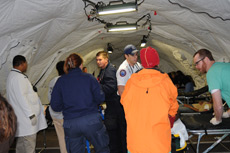PHOTO ALBUM
 AURORA, CO - Several bombs have gone off throughout the town of Aurora, Colorado just as political figureheads have come together to speak at a town hall meeting at the local community college. Hundreds have been injured and hospitals are filled beyond capacity, leaving responders with no choice but to treat patients directly in the field.
AURORA, CO - Several bombs have gone off throughout the town of Aurora, Colorado just as political figureheads have come together to speak at a town hall meeting at the local community college. Hundreds have been injured and hospitals are filled beyond capacity, leaving responders with no choice but to treat patients directly in the field.
For many responders such a disaster seems almost inconceivable, but agencies from across Colorado were faced with this scenario during a mass casualty training event held on November 11th at the Community College of Aurora. The exercise was organized by the school’s Center of Simulation – a department that trains students and real-life responders through the use of medical simulation technology – and the University of Colorado to assess how well the state’s various response agencies are prepared to work together during a large-scale emergency.
As part of the exercise, responders were called to the school following a fictitious explosion at the meeting. Nearly 200 people were injured by the blast, including a state senator and his family, a house representative and the town mayor.
Personnel quickly set up a command and control center on site. The facility, a 195 square foot DRASH 2XB Shelter supplied by DHS Systems LLC, was equipped with DRASH Deployable Command and Control Equipment (DC2E). Officials attending the exercise, including the Director of Homeland Security for the State of Colorado, the First Lady of Colorado, congressmen and various state and local legislators, used the communications equipment to view footage being filmed directly at the scene.
Nearby, medical staff, faced with an overwhelming surge of patients, set up a 748 square foot DRASH M Shelter outfitted with generators, cots and medical equipment as a mobile field hospital. Doctors from local hospitals used the facility to treat about 80 “victims.”
“The medical personnel involved in the exercise were extremely grateful to have the shelters,” says DRASH Fort Riley Support Facility Manager Mark Williams, who attended the exercise. “They found our equipment extremely easy to work with and were pleased that, despite having to work in the field, they were able to set up all the cots and medical equipment they needed to do their jobs.”
 Since its inception, the Center of Simulation has trained responders, from U.S. Army medics to local police and fire departments and emergency medical services, for small- and large-scale disaster incidents. Officials at the school say exercises such as the one conducted last week are imperative to preparing agencies from all different levels to work together in an emergency.
Since its inception, the Center of Simulation has trained responders, from U.S. Army medics to local police and fire departments and emergency medical services, for small- and large-scale disaster incidents. Officials at the school say exercises such as the one conducted last week are imperative to preparing agencies from all different levels to work together in an emergency.
“Despite events like 9/11 and Hurricane Katrina that have shown us what can happen when there is a breakdown in communication, many departments are still not ready to work together in the event of wide-spread crisis. This exercise allowed state and local responders to come together and see how well they can communicate and work side by side,” says Pony Anderson, NREMT-P and Simulation Coordinator for the Community College of Aurora, who helped organize the event.
She adds that DRASH equipment was crucial to the exercise’s success.
“If a real-life situation like this were to occur, hospitals would not have the space available to treat the resulting number of patients. Responders would have to treat people in the field and in Colorado, where we often are faced with extreme snow and below freezing temperatures, these shelters would be critical to preventing loss of life.
“And the number of uses we found for the DC2E was astronomical. During a disaster, the system can help responders perform command and control operations. And we can always pack it up and use it to train responders located in more rural areas who don’t have access to simulation exercises such as the one we conducted.”
With responders able to set up the DRASH Shelters and treat patients from the field over the course of just a few hours, the Center of Simulation is pleased with the recent training event.
“We definitely were able to mimic a real crisis and force responders to think about what they would need to do in such a grave situation, which is what we wanted to accomplish,” says Anderson. “Our participants were incredibly pleased with the training they received.”